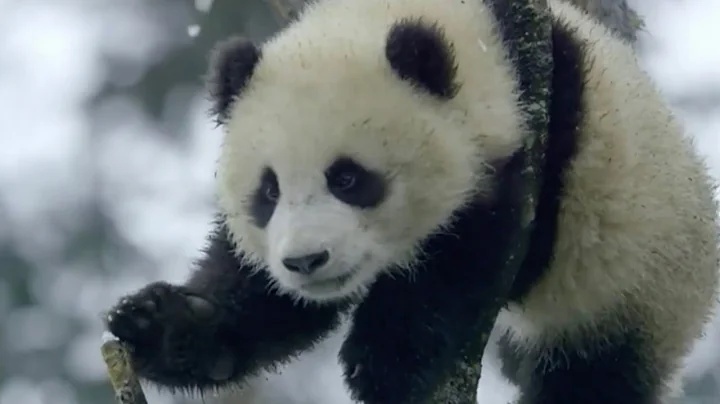China Central Broadcasting Network, Beijing, July 5. According to the China Voice of China’s “News Hyperlink” report, did you know that giant pandas have a “sixth finger”?
Recently, Wang Xiaoming, a visiting researcher at the Institute of Vertebrate Paleontology and Paleoanthropology, Chinese Academy of Sciences and a researcher at the Los Angeles Museum of Natural History, Deng Tao, a researcher at the Institute of Vertebrate Paleontology, and Ji Xueping, a researcher at the Kunming Institute of Zoology, Chinese Academy of Sciences, collaborated with their colleagues to publish an article in the international journal Science Report" published a paper on the evolution of the sixth finger of panda from to "pseudo-thumb".

Giant panda grasps and chews bamboo (photo by Sharon Fisher, photo provided by Wang Xiaoming)
Is the "sixth finger" of the giant panda a finger? How did giant pandas evolve their habit of eating bamboo? What are the differences between primitive pandas and today’s giant pandas?
What is the "sixth finger" of the giant panda?
Deng Tao, director of the Institute of Vertebrate Paleontology and Paleoanthropology, Chinese Academy of Sciences, said that mammals basically have five fingers or toes. Of course, some animals have degenerated conditions, such as horses with only one toe on each foot. Giant pandas are very different from other animals. They have the so-called "sixth finger".
The five fingers of the giant panda are the same as the five fingers of the cat. They all grow in one direction, and the thumb and the other four fingers cannot be held opposite each other. This is not a big problem for cats, but giant pandas mainly eat bamboo. If there is no finger that can be held with other fingers, they cannot hold the bamboo pole, so giant pandas evolved a "sixth finger".

Comparison of the hands of giant pandas (B, D, E), primitive bears (A) and humans (C) (Photo courtesy of Wang Xiaoming)
Unlike the five fingers on the forelimbs of other mammals, the giant panda's "sixth finger" ", also called "pseudo thumb", it is an enlarged wrist bone - the radial sesamoid bone at the front end of the palm. sesamoid bones are free bones in muscles or tendons. They are found in almost all animals, but they are different in composition from real bones. Human sesamoid bones are usually cartilage and play a role in stabilizing joints. The radial sesamoid bone of the giant panda has become longer, like an extra "thumb", allowing it to grip the other five fingers, so that it can grasp the bamboo pole and prevent it from slipping.
Giant pandas have a long history of eating bamboo!
"The giant panda has changed from a carnivore that 'put down the butcher knife and became a Buddha on the spot' to eating plants, especially focusing on eating bamboo. It has many physical changes." Deng Tao said that giant pandas need to have the necessary skills to eat bamboo. The two conditions are: one is to have teeth with strong biting force, and the other is to have a "pseudo thumb" with the function of gripping. This is also a prerequisite for giant pandas to evolve the habit of eating bamboo.
Like the grooves on the stone grinding surface used to help grind beans, the teeth of giant pandas are the same, with many "folds" on the tooth surface. Research has proven that giant pandas’ teeth were already equipped to eat bamboo 8 million years ago. In sediments dating back 100,000 years ago found in a cave in Guizhou, evidence was found that giant pandas evolved a "pseudo-thumb" with an opposable grip function, but no fossil evidence of a "sixth finger" was found.
The "pseudo-thumb" fossil of Eo-panda discovered in Shuitangba, Zhaotong, Yunnan pushes the inference forward to 5.9 million years, that is, at least 6 million years ago, Eo-panda already had the habit of eating bamboo. Deng Tao affirmed the significance of this discovery.
EoPanda ≠ Giant Panda
EoPanda is another genus that is different from the current giant panda, Deng Tao explained, but they have an evolutionary relationship, which can prove that EoPanda is the ancestor of the giant panda.

Ecological restoration map of the ancestors of giant pandas in Shuitangba, Zhaotong, Yunnan (drawn by Mauricio Antón, photo provided by Zhaotong Institute of Cultural Relics Protection and Archeology)
There are big differences between primitive pandas and giant pandas. In terms of body size, the panda is 1/3 smaller than the giant panda.In terms of the details of the teeth, the length of the dentition of the Eo-Panda is only 2/3 of the length of the dentition of the Giant Panda; the teeth of the Giant Panda are completely dense, while the gaps between the teeth of the Eo-Panda are relatively wide; the width of the teeth of the Giant Panda is greater than the length. The teeth of the Eo-panda are longer than they are wide; the "folds" of the giant panda's teeth are relatively dense and can effectively help grind bamboo, while the "folds" of the Eo-panda are deep and long.
In terms of living environment, the fossils of primitive pandas are distributed in Yunnan, which is like spring all year round, while the fossils of giant pandas are distributed in the high mountains of Sichuan or the Qinling Mountains of Shaanxi.
Deng Tao believes that exploring the laws of the relationship between biological evolution and the natural environment can provide reference for the future development of mankind and help mankind better protect the environment and biological diversity .
Producer: Guo Jing
Reporter: He Jia Yang Yang
Editor: Pan Yuwei Yang Ran





















